COMPLETE EPISODE GUIDE WITH CRITICAL COMMENTARY
Season 5 (1963-64)
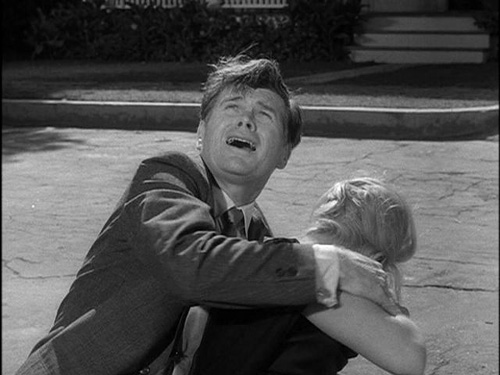
SEARCH THIS GUIDE BY SEASON: Season 1 (1959-1960) ; Season 2 (1960-1961) ; Season 3 (1961-1962) ; Season 4 (1963) ; Season 5 (1963-1964)
I - Superior; II - Excellent; III - Very Good; IV - Fair;
V - Below Average; VI - Not Good.
NEW SEASON 5 ARTICLE (80 pages)
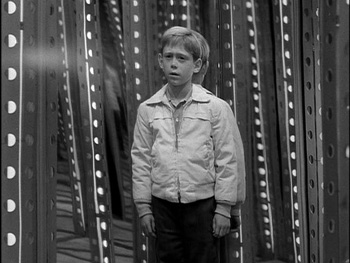
ORIGINALLY BROADCAST AS EPISODE 121
STARRING CAST: Jack Klugman, Bill Mumy, Connie Gilchrist, Russell Horton, S. John Launer, Bob Diamond
WRITER: Rod Serling
DIRECTOR: Joseph M. Newman
SUMMARY: Max Phillips' son Pip is dying in a place called South Vietnam. He gets one last chance to see Pip before he himself dies.
REVIEW: III
Jack Klugman and Bill Mumy were teamed up for their final "Twilight Zone" appearances in this touching story about an alcoholic single father whose teenaged son is in Vietnam. This was yet another Serling prediction of turbulent things to come in the world. As Max Phillips says, "There isn't even supposed to be a war going on there." Like "The Purple Testament" and "A Quality of Mercy", Serling was once again writing about what he knew all too well. Klugman's enormous range shines through as per usual, and Mumy is especially poignant in the climactic house of mirrors sequence. This show was filmed mostly at the former Pacific Ocean Park in southern California. Bill Mumy remembers the episode well. After two previous TZ appearances and a host of other credits to his name at the young age of nine, Mumy was already well on his way to child stardom in 1963. "We filmed most of that down at the old Pacific Ocean Park, right near where the Santa Monica pier is. It was fun. I've run into Jack Klugman since then, once when he and my son were working together on something, I think. We both had good memories of "In Praise of Pip." The house of mirrors thing was pretty intense." Bobby Diamond, remembered for a handful of roles including the film "Fury" and TV on "Dobie Gillis", plays the older Pip who has survived the challenges of Vietnam and returned home after his father's death. Diamond went on to a successful career as an attorney in the Los Angeles area. He remembers, "That role, ironically, couldn't have been more ideal for me at that moment in time. I'd had a knee injury and was actually on crutches when I went in to read for it. On film, I think I just used a cane. And the kid, Pip, was supposed to walk with a limp. I only worked about a day, maybe two, on that set, but it was a good time."
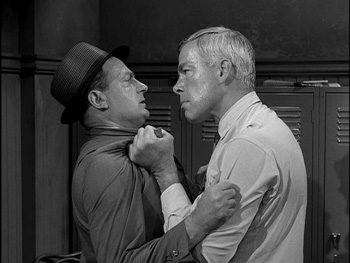
ORIGINALLY BROADCAST AS EPISODE 122
STARRING CAST: Lee Marvin, Joe Mantell
WRITER: Richard Matheson
DIRECTOR: Don Weis
SUMMARY: The year is 1974, and prizefighting has been abolished. Only robots, not humans, can participate in the sport. Steel Kelly, a former prizefighter, and his partner Pole, manage a robot named Battling Maxo, who breaks down just before a bout with Maynard Flash. Illegally, Steel steps in and takes on Flash.
REVIEW: II
Lee Marvin didn't do much television - the big screen was his home. His two "Twilight Zone" showings represent some of his finest work outside the western milieu that made him a household name. Conversely, Joe Mantell was not a well-known actor, but like Marvin, had the resources to make good scripts great, just as he'd done in Serling's "Nervous Man in a Four Dollar Room".
"Steel" has always been Matheson's favorite of the scripts he wrote. In "Death Ship", the same two-character confrontation is observed between Jack Klugman and Ross Martin. Here we have Pole, the realist, and Steel, the bullhead. Together, the two generate a lot of static as they try to survive an unlucky turn of events.
The 'bout between Battling Maxo and Maynard Flash was staged wonderfully well - this was no set of bleachers or stock footage of a crowd seen in "The Big Tall Wish" or "A Most Unusual Camera". This was an actual smoke-filled arena with hecklers shouting such lines as, "Get that pile-a junk outta here!", "Hey, it's Rattling Maxo!", "Scrap iron, scrap iron!" The makeup used on Chuck Hicks and Tipp McClure, who played the robots, was the usual flawless handiwork of William Tuttle. If there were ever to be prizefighting robots who resembled humans, they'd definitely look much like the way Tuttle conceived them. Chuck Hicks: "I did five or six motion pictures with Lee Marvin and we'd never get the shooting started until 1 pm or later. He could drink, but he was a great guy, despite it. Lee loved to go to the watering hole after work, start up conversations about various things and get his cronies into debates. Then he'd just sit back and watch them...it was hilarious for him. I remember the plastic eyes I had to wear for the show would get clouded up by body heat, and a few times I really socked Lee good, accidentally. He shrugged it off saying 'don't worry about it, I understand your problem!'"
If there is any fault to be found in "Steel", it would have to lie in Marvin's getting bulldozed when he takes on the electronic robot...the crowd never catches on to the blood and sweat pouring from Steel Kelly, or the fatigue that descends upon him after about a minute in the ring, pitted against the competent Maynard Flash - the words of the closing narration say it best: "proof positive that you can't outpunch machinery." At the same time, this is a credit to how convincingly the movements of the robots came off. But the abolition of prizefighting?! This is not something that would ever take place in our world, at least not without considerable protest...making "Steel" bonafide "Twilight Zone."
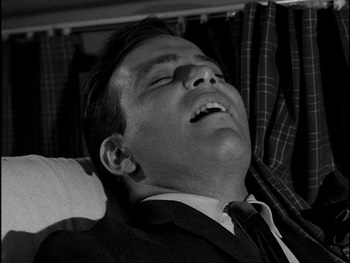
ORIGINALLY BROADCAST AS EPISODE 123
STARRING CAST: William Shatner, Christine White, Asa Maynor, Ed Kemmer
WRITER: Richard Matheson
DIRECTOR: Richard Donner
SUMMARY: Bob Wilson flies home after six months in a sanitarium after experiencing a mental breakdown on a previous flight. En route, he encounters a horror beyond words.
REVIEW: I
The first of six episodes directed by Richard Donner, who in those days was a young upstart. After proving himself with the difficult "Nightmare at 20,000 Feet" by Richard Matheson, he was immediately hired to direct some 'easier', albeit lesser quality scripts, "From Agnes with Love", "Sounds and Silences", "The Brain Center at Whipple's", "The Jeopardy Room" and "Come Wander with Me".
Indeed, "Nightmare at 20,000 Feet" was a challenge that required plentiful resources. In Serling's "The Odyssey of Flight 33", Justus Addiss worked some magic with a flight that was travelling through time. Both of the planes are in trouble, but this one is being jeopardized by a strange-looking man-creature in the midst of a thunderstorm. Unfortunately, the creature has not taken the years very well - it looks all too much like a man in a wooly sheep Halloween costume walking around on the wing. When it came time to re-make this segment of the 1983 "Twilight Zone: The Movie", the director (George Miller) remembered the problem and gave John Lithgow a bonafide gremlin who seems like it could literally rip the plane apart if it wanted to. But this is the only downfall in a suspenseful and superbly-scored televisional masterpiece (with musical cues from other "Zone" scores by Bernard Herrmann and Jerry Goldsmith).
William Shatner was at his very best as the palpably frightened family man, Robert Wilson. His terror over the current flight can only leave us to imagine what his original flight, which was terminated en route, was like...and what drove him into a sanitarium. Supporting well were Christine White (last seen in "The Prime Mover"), Ed Kemmer (star of the now-forgotten early sci-fi TV series "Space Patrol") as the flight engineer, and Asa Maynor as the stewardess (Matheson gave her a name in his script, although we never hear it - Betty Crosby). Shatner carries the show, mostly with terrified expression, and the writing is Matheson's usual superb horror. Above all, "Nightmare at 20,000 Feet" is an eye-opening thriller that invokes 'what if's'...just how would you respond if you looked outside the window and a man was out there on the wing?
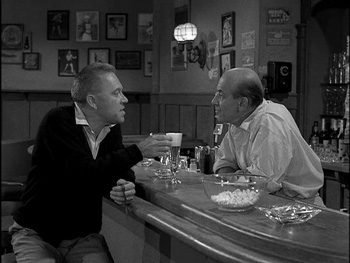
ORIGINALLY BROADCAST AS EPISODE 124
STARRING CAST: Richard Erdman, Doris Singleton, Herbie Faye
WRITER: Rod Serling, based on a story by Milton D. Rosenthal
DIRECTOR: John Rich
SUMMARY: Patrick Thomas McNulty, the 'biggest bore on Earth', is given a stopwatch that has the power to stop time. Then one day, the stopwatch breaks and leaves everyone frozen...except him!
REVIEW: V
This episode was re-made in 2002 as an entertaining radio drama starring Lou Diamond Phillips. The television version starred character actors Richard Erdman, Doris Singleton, and Herbie Faye, but it goes nowhere. It relies on a simple freeze-frame gimmick, controlled by the stopwatch, as its only real thing of interest. In the radio version, Phillips is quite funny as the long-winded McNulty. In the original, Erdman's character merely annoys. Directed by John Rich, who at that time was heavily into chores on "The Dick Van Dyke Show" (on which Erdman, Singleton, and Faye were semi-regulars), this is one "Twilight Zone" comedy that might have played better if it had spent another week in the story editor's office undergoing rewrites.
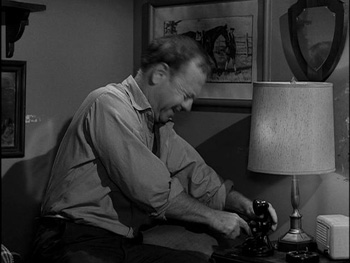
ORIGINALLY BROADCAST AS EPISODE 125
STARRING CAST: Mickey Rooney
WRITER: Rod Serling
DIRECTOR: Joseph M. Newman
SUMMARY: Michael Grady gets banned from horse racing, but gets an offer from some higher power who wants to know what his number one ambition is. He says he wants to be big. Then the racing commission calls him and reports that he's been given a second chance. But now he's about twenty feet tall and can't even wear his own clothes!
REVIEW: V
As in "Nervous Man in a Four Dollar Room", here we have a two-character confrontation between a man and his conscience. But unlike his forerunner Jackie Rhoades, Michael Grady ends up badly. Much like the character of Sammy Hogarth he portrayed in Serling's "The Comedian" in 1957, Grady is not a likeable man nor an inherently worthy individual - he's been beaten up by his own rotten disposition. Thus, his predicament of not being able to ride a horse comes off rather inconsequentially. However, the 'Serling moral' is intact - be careful what you wish for, you just might get it. An interesting tidbit of information - a year or so later in 1965, Mickey Rooney starred in a short-lived sitcom, "Mickey", where his character's name was Mickey Grady. Emmaline Henry, best known as Mrs. Amanda Bellows (wife of the great Hayden Rorke's Dr. Bellows) of "I Dream of Jeannie", played Mickey's wife Nora. Ms. Henry was a superlative actress who appeared in numerous comedy TV shows, and sadly she died far too young.
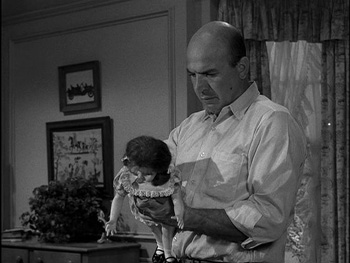
ORIGINALLY BROADCAST AS EPISODE 126
STARRING CAST: Telly Savalas, Mary LaRoche, Tracy Stratford, and featuring the voice of June Foray
WRITER: Jerry Sohl
DIRECTOR: Richard C. Sarafian
SUMMARY: Annabelle Streator buys a wind-up talking doll for her daughter Christie, much to the consternation of Christie's stepfather. But this is no ordinary doll - this doll can commit murder.
REVIEW: I
The penultimate script by Jerry Sohl, credited solely to Charles Beaumont, was the morbid and unforgettable chiller "Living Doll". This goes many steps beyond another semi-terrifying story about an evil inanimate object, showing the results of broken homes and evil stepparents who succeed in traumatizing their stepchildren...especially when they aren't able to have any biological offspring. The stepchild in this story has apparently been so rejected and psychologically unstable to the point that she sees a psychiatrist - which was much rarer for children of the 1960s and before - and the stepfather has a good time taunting this. Depending upon the viewer's perspective, the doll can be viewed any number of ways: namely, a cold-blooded murderer or a hallucination on the part of the jealous stepfather. Or perhaps a protector of his stepdaughter. Or even as a symbol or voice of the stepdaughter, which he tries to expunge but knows he can't.
The leading man was pre-"Kojak" Telly Savalas as burly, cold-hearted Erich Streator, who married only for convenience. As the gentle yet no-nonsense mother Annabelle, Mary LaRoche was a good choice. She also played a mother in a one-scene part in Serling's "Requiem for a Heavyweight" in 1956, and the sensible, pretty mistress in "A World of His Own" three seasons prior. Tracy Stratford (who played the daughter in "Little Girl Lost") returned to play the daughter here as well. But who was Talky Tina? None other than June Foray - who did not receive screen credit, but the voice she provided (with the aid of perfect sound effects) gave a lasting impression. Bernard Herrmann's last of eight scoring assignments for "Twilight Zone" was "Living Doll." What he came up with was a wicked waltz in 3-beat time scored for bass clarinet, two harps, and celeste. The episode was also photographed very well, particularly the scenes where Streator tries to chop the doll's head off with a table saw and burn her with a welding torch. No matter how hard he tries, nothing but nothing at all will scathe the ruthless Talky Tina. "And no one has dared forget it!" remarks June Foray.
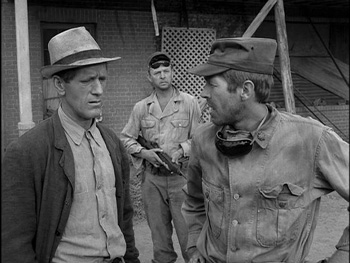
ORIGINALLY BROADCAST AS EPISODE 127
STARRING CAST: John Anderson, James Coburn, John Marley
WRITER: Rod Serling, based on a short story by Henry Slesar
DIRECTOR: Alan Crosland, Jr.
SUMMARY: An unidentified authority figure named Major French and his troop head into a small village on the east coast after a nuclear war. They are a small, surviving colony that lives by instructions from a Godlike "Old Man" who communicates with Goldsmith, the appointed town leader. But none of the citizens have ever seen the Old Man. French tries to take control of the village and undermine Goldsmith's authority, demanding that this Old Man be revealed to everyone once and for all.
REVIEW: IV
James Coburn and John Anderson display a fine balance of forces here - Coburn as a self-proclaimed government official/political agitator and Anderson as the leader of the town, vaguely similar to Captain Benteen in "On Thursday We Leave for Home." Set in 1974, perhaps it reflects an omniscient knowledge of an overzealous world, succumbing to technology and as a result, turning into a dying wasteland. "The Brain Center at Whipples" and "Probe Seven - Over and Out", done later in the season, explore similar themes. This was Anderson's last of four strong "Twilight Zone" appearances, and perhaps his best. In "A Passage for Trumpet", "The Odyssey of Flight 33" and "Of Late I Think of Cliffordville" he took a strikingly deadpan approach to the roles. Here, he is much more lyrical as the last survivor of a colony. Coburn generates a fair amount of steam throughout, but his energy isn't quite enough to carry things. Where this episode falls short is in the underlying title character... the 'Old Man' is an entity sitting behind a barricade, which sends out notes to Goldsmith. The moment of revelation is terribly anticlimactic as the townspeople attack it and die soon after.
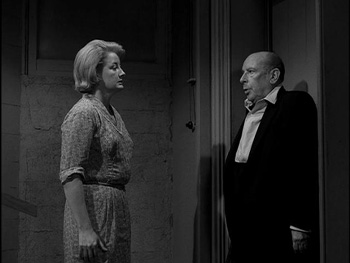
ORIGINALLY BROADCAST AS EPISODE 128
STARRING CAST: Cedric Hardwicke, Constance Ford, Ian Wolfe
WRITER: Rod Serling
DIRECTOR: Don Siegel
SUMMARY: Barbara cares for her Uncle Simon, who can't stand the sight of her and vice versa. Barbara will get his entire inheritance, provided she stays in his house and cares for his latest invention.
REVIEW: V
Barbara has been caregiver to her uncle Simon Polk, a retired scientist and despicable human being, for the last twenty-five years. Obviously, she's only been in it for the estate she ultimately inherits. So, he's spent his post-stroke years building a robot that will take his place once he's gone to the grave. If she fails to care for the robot, she'll be shown the door by Simon's lawyer. If she stays, she'll inherit his entire estate. Cedric Hardwicke and Constance Ford (who played Edward O'Brien's fiancee in Serling's "The Comedian") cat it up very well with some classic old-school barbs. But instead of seizing the moment and getting out of the "decaying barn" once and for all, "Raggedy-Ann corpse" Barbara decides to stay locked up with the robot, who demands the same "hot chocolate in the English bone china cup" just as "ancient albatross with the dirty mouth" Simon did. Robby the Robot from "The Forbidden Planet" was hauled out of storage to play Simon's robot.
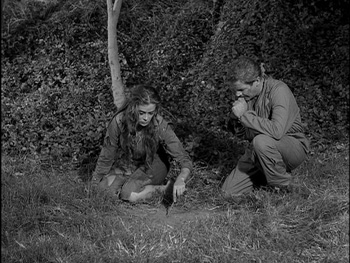
ORIGINALLY BROADCAST AS EPISODE 129
STARRING CAST: Richard Basehart, Antoinette Bower, Harold Gould
WRITER: Rod Serling
DIRECTOR: Ted Post
SUMMARY: Adam Cook crash-lands on a planet several light years away from Earth. His spaceship is destroyed and he must stay on the planet permanently; his home planet has just undergone war and is destroying itself en masse. Adam meets Eve Norda, and they set out to colonize the place.
REVIEW: V
English actors Richard Basehart and Antoinette Bower star in this story by Serling about Adam Cook, who gets lost in space, crash-landing on another planet. Back on his home planet, war is imminent. Cook's ship is permanently destroyed, and only a small TV monitor for communication (Harold Gould, known best for his long-running role as Rhoda's father on "Rhoda", plays a government official). Owing to the governmental complications, there is no way to send out a rescue mission. This planet, however, has apparently not been colonized and Col. Adam Cook and Eve Norda are forced to develop it. At first, Eve rejects him, but soon they realize they need each other. She picks up some dirt from the ground..."earth", she seems to say. So, they decide to call the place Earth. She offers him "food" from a nearby fruit tree, that resembles an apple tree. And out they set to colonize this new place.
"Montgomery Pittman's "Two", Space Age Style" might be a better title for "Probe 7 - Over and Out". Characteristic of the later episodes, its long-winded, almost oratory speeches from the main character are substituted for action. The staging of the planet is adequate, but looks far too much like the 'Earth' we know. And the notion of Adam (on a one-man mission in space) and Eve (whose appearance on the planet is never explained too well, but certainly she was no space traveller) being put in charge of developing a new race on a planet only four light years away from technologically-advanced Earth seems more than a little hard to fathom, even for "Twilight Zone". Director Ted Post says, "I thought Richard Basehart and Antoinette Bower worked very well together ; they took what was essentially a bland script and made it interesting. But by this time, Rod was worn out - he gave it to me and said, 'Just do your best with it.'" Antoinette Bower recalls, "It was a great shoot - Richard Basehart was so great - I remember I was worried that I wouldn't be finished in time. I had planned to go back east for the march in Washington. Luckily, I made it!"
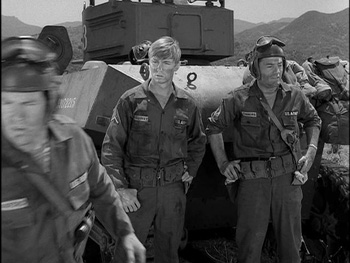
ORIGINALLY BROADCAST AS EPISODE 130
STARRING CAST: Ron Foster, Warren Oates, Randy Boone, Robert Bray
WRITER: Rod Serling
DIRECTOR: Alan Crosland, Jr.
SUMMARY: Custer's Last Stand takes on a whole new meaning...in 1964.
REVIEW: III
An episode often-criticized and underrated for its so-called dullard characters and implausible premise, this is a marvelously well-written piece about time travel in the context of Custer's Last Stand. There are several fine "TZ suspense gems", including a horse galloping by without a rider after Private McCluskey (Randy Boone) fires into a dust cloud, then getting an arrow shot into his back when he goes down a hill to investigate some mysteriously-placed wigwams. The juxtaposition of past and present does not fail to engage the viewer, as if one frame of spacetime were moving backwards and the other staying in the present. Whichever way the viewer perceives it, the historical details of the time of the Last Stand at the Big Horn and Little Big Horn rivers are well integrated into the present.
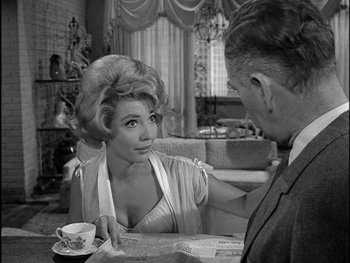
ORIGINALLY BROADCAST AS EPISODE 131
STARRING CAST: Patrick O'Neal, Ruta Lee, Walter Brooke
WRITER: Rod Serling, based on a story by Lou Holz
DIRECTOR: Bernard Girard
SUMMARY: The aged Harmon Gordon, who's married to a harpie, seeks a fountain of youth...and he finds it!
REVIEW: IV
Perhaps better titled "A Long Drink from a Certain Fountain", this show was adapted from an idea of a Mr. Lou Holz. The idea was certainly not original, however. Harmon Gordon is injected with some rejuvenating serum, and returns to infancy. Harmon is married to a gold-digging young tramp named Flora. Ruta Lee was a perfect choice for the part, and it became one of her personal landmarks, offering up such snipery as, "Well, Harmon, what'll it be this evening? An evening of listening to records of 'Come to the Wildwood Church' or any other such red-hot toe-tapping numbers? You'd better be careful, Big Daddy, because if you take me to a swinging weekend in Egypt, I may just run away with a mummy." She merely lives to spend his cash and break the antiques in his house...out with the old, in with the new. "I loved that part," says Ruta Lee. "I've always loved playing bitches because that's what I play the best!!"
The curious thing is that Flora is never told of the injection, but of course, she's dying to find out what the heck happened to him. It is nonsensical that Harmon's brother (character actor Walter Brooke, who had a small but significant part as Mr. McGuire, the 'plastics' man in the immortal 1967 feature "The Graduate") didn't seize the opportunity to get him away from Flora once and for all; instead, he makes her into Harmon's new mother.
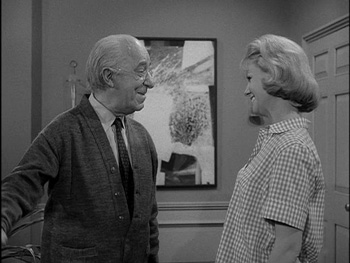
ORIGINALLY BROADCAST AS EPISODE 132
STARRING CAST: Ed Wynn, Carolyn Kearney, James Callahan, William Sargent
WRITER: Richard DeRoy, based on a story by George Clayton Johnson
DIRECTOR: Roger Kay
SUMMARY: Sam Forstmann's prized posession is a grandfather clock, which was presented to him on his first birthday, 76 years ago. He's convinced that when the clock winds down, he'll die.
REVIEW: V
George Clayton Johnson's last "Twilight Zone" entry - in largely disguised form - was this story starring Ed Wynn. Carolyn Kearney (who appeared in Serling's "The Time Element") and James Callahan were cast as the co-stars. Richard DeRoy wrote the final version that was aired. The results were so unpalatable that Johnson's name never ended up in the credits (the story is credited, curiously enough, to a certain Mr. Johnson Smith). In "One for The Angels", Wynn played an aging man whose time had come to die. Here he plays the same character, who this time is obsessed by the fact that the grandfather clock presented to him on the date of his birth will strike its last second at the same time that his heart strikes its last beat. As the slow-running clock winds down for the last time, he leaves his body and is finally able to convince himself that the clock hasn't kept good time for many years and that he probably still has a few more years left. He claims to his granddaughter that when the clock stopped for good (when his spirit rose out of his body), that he was re-born.
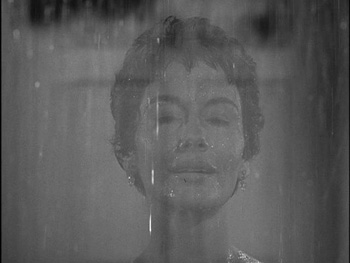
ORIGINALLY BROADCAST AS EPISODE 133
STARRING CAST: Maggie McNamara, Mary Munday, David Macklin, Hank Patterson, Betty Lou Gerson
WRITER: Earl Hamner, Jr.
DIRECTOR: Alan Crosland, Jr.
SUMMARY: Movie star Bunny Blake, whose roots are in a small town called Howardville, goes back for a visit at the advice of a magical ring. The visit turns out to be a goodbye to the people who supported her career.
REVIEW: III
Yet another engaging yet underrated episode was "Ring-a-Ding Girl" starring Maggie McNamara, then in her early thirties but whose life would end tragically in suicide a number of years later. Like several other episodes including Serling's "The Seventh is Made Up of Phantoms", the splicing of spacetime continuum is the basis for the story. The gimmick here was a magic ring that serves as Bunny Blake's guide. She returns home to Howardville just long enough to reacquaint with her old cronies, which ironically serves as her opportunity to say her goodbyes before the plane she's on crash-lands in her hometown. The end of the second act, where Bunny is in Hildy's house one moment, then walks out the door and fades away the next, is very touching. Unfortunately, the episode is rarely discussed, if for no other reason than only strong performance in the episode comes from Mary Munday, who is excellent as Hildy, Bunny's sister. David Macklin, who played Bunny's newphew, comments: "The short-sleeved shirt I had to wear for that role was certainly unusual. Quite ugly, in fact! The director and I didn't communicate so well...and I thought he should have included a close-up shot of [Mary Munday and myself] at the very end instead of the long shot that was used...for some reason, he didn't, but a lot people remember my work on that particular segment, more than most of the other things I did."
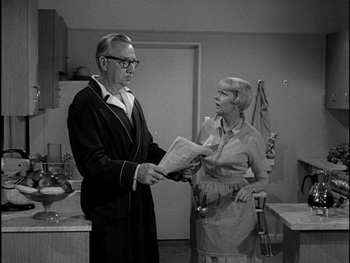
ORIGINALLY BROADCAST AS EPISODE 134
STARRING CAST: Edward Andrews, Hellena Westcott, Kevin Hagen
WRITER: Earl Hamner, Jr.
DIRECTOR: John Brahm
SUMMARY: Oliver Pope, businessman, becomes Oliver Pope, hit-and-run driver. The police may not have any luck finding Pope, but his car doesn't let him off the hook so easily.
REVIEW: IV
In "You Drive", Earl Hamner wrote a familiar story about a hit-and-run, where a car comes alive and torments the owner-turned-criminal. Hamner's obvious distaste for the snarly urbane professional is transparent; by this time, the native Virginian writer and his family had been California residents for a few years and no doubt experienced more than a few of the Oliver Pope Hollywood types...or at least met a few more people who would leave someone near death at the expense of saving their own neck.
Edward Andrews, always reliable for evil male leads, turns in his usual fine work as heartless Oliver Pope, supported well by Hellena Westcott as his June Cleaverish wife, Lillian. Constantly spooked and tormented by his automobile, it's clear that the car is going to choke him to death...or at least until he confesses to the crime. Meanwhile, the paranoid Pope is trying to fend off young Pete Radcliff (character actor Kevin Hagen) who he imagines is trying to steal his job. Even after Pete gets arrested at the scene of the crime which he didn't commit, Pope doesn't even bat an eyelash at the obvious mistake.
If nothing else, "You Drive" lacks energy; it was simply done too late in the series. The car chase sequence at the end, with rainstorm, is what most people remember, directed well by John Brahm. "Twilight Zone" tried this a few years earlier in "A Thing About Machines" and it failed. This time, the details were given the attention they deserved.
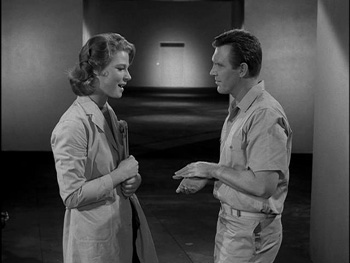
ORIGINALLY BROADCAST AS EPISODE 135
STARRING CAST: Robert Lansing, Mariette Hartley, George Macready, Edward Binns
WRITER: Rod Serling
DIRECTOR: Robert Florey
SUMMARY: Commander Douglas Stansfield gets an assignment - he's to go on a space mission that will last 40 years, but he himself will not age during the mission. Just before departing, he meets Sandra Horn, whom he is relucant to leave.
REVIEW: V
Characteristic of the later Serling scripts, including this one, is characters rambling endless theoretical-sounding discussions of the obvious.
"The Long Morrow" certainly sets up a compelling idea, but no one in his right mind would plan a space journey that would last forty years, at least not without first ensuring that the voyager could make it back in a short time if the mission was a failure or unnecessary. Obviously, new technology will answer current questions such as whether or not there is life in places other than Earth. Not only that, but the scientist would be coming back to an Earth he hardly knows, one that would be technologically far surpassed and would long-since have answered the question he had set out to find an answer to (which in fact was the case here). Even more painful is the fact that Stansfield arbitrarily removed himself from hibernation six months into the mission, thus causing himself to age, and spend forty years alone in the cockpit of a space vessel. This too is unfeasible. All the while, Sandra Horn had placed herself in seclusion to prevent aging, so they could spend their lives together after he returned. Quite a communication gap between them, yet all this is made to be a magnificent resolve. But in traditional "Twilight Zone" fashion, the acting makes the material pass. Mariette Hartley and Robert Lansing turn in bravura performances.
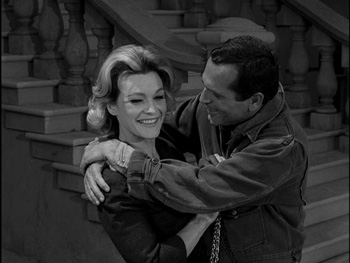
ORIGINALLY BROADCAST AS EPISODE 136
STARRING CAST: Don Gordon, Gail Kobe, Vaughn Taylor, Douglas Dumbrille, Doug Lambert, J. Pat O'Malley
WRITER: Jerry McNeely, based on a story by Henry Slesar
DIRECTOR: Don Seigel
SUMMARY: Salvadore Ross, a man with little class, decides to turn himself around. And he does, thanks to a most unusual talent.
REVIEW: V
Don Gordon and Gail Kobe returned to "The Twilight Zone" in this story about a young man who sells years of his life...as well as select other things that will somehow miraculously lead him back to the woman he desires. In the process of trying to get Leah, his girlfriend, to escape from the reigns of her war-vet-schoolteacher father and spend her life with him, he breaks his fist in anger. The first act shows Sal exchanging his broken hand for an old man's bronchitis... he has some kind of unexplained power that allows him to carry out such exchanges. Then the rich businessman he works for (aged 72) agrees to sell his years to Sal...thus making Sal an old man and the businessman young. Then Sal sells a year of his life to a young paperboy who works in the apartment building. At the blink of an eye, the still-old Sal manages to sell his years to a cash-desperate young elevator operator. Having become rich from the sale, he hires a college student to help him improve his way of talking. He revisits Leah and her father, and now suddenly he manages to win her over. He also manages to "buy" Leah's father's compassion. Luckily, after just a few hours she's able to see right through all of this and refuses to spend more time with him. A week later, he returns to Leah's home and confronts her father, saying that he's very much in love with Leah and can't survive without her. But it's too late...Dad has always hated Sal, to whom he already sold his 'compassion', and shoots him dead on the spot.
Needless to say, the course of events does not even come close to adding up. It is full of unexplained twists and turns and unresolved events (the most glaring one being an elevator operator gaining forty years onto his life within the span of a few seconds). At the beginning of the story, Leah is almost adamant that she never wants to see the sight of Sal again, yet after only a week or so, she is anxious to spend more time with him. The swapping power that this rather commonplace guy named Sal supposedly has is laughable and no more than a conveniently-contrived plot element. It is not clear as to whether or not he really improves himself, but he doesn't deserve to be killed, thus leaving Leah completely alone in the world.
Kobe was again a good choice for the female lead, having done so superlatively in "In His Image" a year earlier, and she plays the role with passion. "Don Gordon was a very special actor - and Don Seigel, who directed, was great. He was responsible for shaping Clint Eastwood's career...and Clint hasn't had a bad career!! I also worked with Henry Slesar later on, when he was writing for "Edge of Night."" Don Gordon does nicely as the sinister Salvadore Ross. Had the story been adapted with more logic and attention to detail, it would have fared with any of the best.
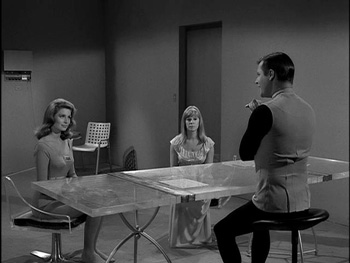
ORIGINALLY BROADCAST AS EPISODE 137
STARRING CAST: Collin Wilcox, Suzy Parker, Richard Long, Pam Austin
WRITER: John Tomerlin
DIRECTOR: Abner Biberman
SUMMARY: Marilyn Cuberle turns 18, but has no desire to undergo the transformation that everyone undergoes at that age. Each person must pick a pattern that will make them "beautiful". She protests, but finally succumbs.
REVIEW: III
The second of two TZ episodes essaying beauty and conformity was John Tomerlin's "Number 12", which starred Collin Wilcox, who had recently put herself on the map with To Kill a Mockingbird.
"Eye of the Beholder" was a statement about ugliness being a crime. Janet Tyler was part of a politically brutal society where everyone practiced "glorious conformity"; she was an outcast. Here, the main character stages a bonafide protest, but to no avail. She doesn't want to be the same as everyone else, and for that attitude she's branded mentally ill. Her world is one where beauty is defined as emotional rigidity and physical similarity. Her ultimate submission to the procedure strikes a wicked chord--she's lost her entire identity and everything she stood for is now eternally evaporated.
The episode opens rather curiously in the sparcely furnished Cuberle living room, where two people are sitting on the couch, against a backdrop of two mannequins labelled "8" and "12". Some twinkly, brisk music (which, incidentally, was part of a stock music suite titled "Brave New World" written by Bernard Herrmann in 1956) plays quietly in the background. Lana Cuberle: "I can't decide...eight or twelve. I think twelve might suit you better." From the onset there's a sense of despondence, a feeling that literally everything in and about this world is mechanical and textbook. Here's an unlikely pair: a strikingly beautiful yet airbrained woman and her homely daughter, an intelligent and thoughtful personality who even looks like she's been trampled by the society she's a part of.
"Number 12 Looks Just Like You" makes its points unobtrusively. The emphasis is usually on morality rather than drama, with a certain amount of cliche thrown in to keep things entertaining for the viewer. Perhaps the greatest attribute of the episode is that it's identifiable. Lost or mistaken identity was a theme that TZ could always be counted on to explore successfully.
Writer John Tomerlin was asked by Charles Beaumont to write the script, and it was completed in three days. However, almost exactly forty years passed before he saw it for the first time. Tomerlin: "I didn't avoid it, but it was associated with such a painful experience in my life [the demise of Charles Beaumont] that I didn't really care to look at it, even though it was on such a great TV show....[Chuck] was not doing well by that time, but knew he could depend on a few of us [writers] to give him what he wanted, when he needed it." Like Beaumont, Tomerlin himself is no fan of television - his ambition was to write radio dramas when suddenly TV came along and he found himself faced with having to adapt to the change. He wrote around thirty-some-odd hours' worth of scripts for shows such as "Lawman", "Wanted Dead or Alive", and "Maverick" in addition to his lone script for "Twilight Zone".
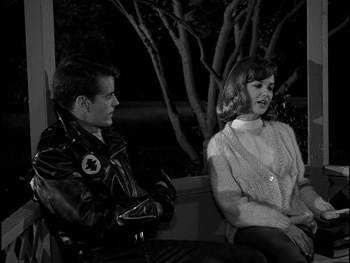
ORIGINALLY BROADCAST AS EPISODE 138
STARRING CAST: Denver Pyle, Shelley Fabares, Michael Forest, Lee Kinsolving, Irene Hervey, Michael Conrad
WRITER: Earl Hamner, Jr.
DIRECTOR: Joseph M. Newman
SUMMARY: Three men on motorcycles arrive in suburbia and rent a house, as they prepare to set up infectious bacteria that will kill everyone on Earth and pave the way for new colonies.
REVIEW: VI
Starring a group of favorite familiar TV actors - Shelley Fabares ("Coach"), Denver Pyle (Uncle Jesse on "The Dukes of Hazzard"), Michael Conrad ("Hill Street Blues") Earl Hamner's story of bikers from outer space offers a good cast in a notoriously weak script. Featuring a 'giant eye' leader who communicates with the motorcyclists from their home planet with instructions to infect the water with invasive toxic bacteria, there are numerous unexplained oddities that make the entire half-hour seem more like a jumble of potentially good ideas.
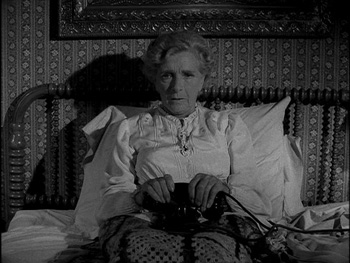
ORIGINALLY BROADCAST AS EPISODE 139
STARRING CAST: Gladys Cooper, Nora Marlowe, Martine Bartlett
WRITER: Richard Matheson
DIRECTOR: Jacques Tourneur
SUMMARY: Miss Elva Keene gets unexplained phone calls in the middle of the night, and eventually find out that they are being made by her dead fiancee!
REVIEW: II
"Night Call" is "The Twilight Zone"'s only bonafide ghost story. While "Twenty Two", "The Passersby", "Stopover in a Quiet Town" and a few others touch the genre, Richard Matheson's script fits the bill in its entirety. And luckily, Matheson was able to get producer Bert Granet to hire Jacques Tourneur ("Alfred Hitchcock Presents", etc.) to direct. As a syndicated newspaper review said at the time, "The plot is stretched a bit thin, but the finale is chilling." True. Gladys Cooper gives an even more credible performance here than she did in "Nothing in the Dark", even if the storyline lingers a bit. After two phone calls from the mystery man, the viewer's suspension of disbelief is tested. But she then confesses to having been the guilty party and responsible for the entire thing - she was a demanding, domineering young lady whose fiancee died of her hands. The finale is indeed chilling and heartbreaking, but it is the penultimate scene that deserves real praise. The lady from the phone company calls Elva Keene once again to let her know that a trace has been run on the line and that there's no way that the caller could have phoned her. As Elva stops at a grave marked Brian Douglas, the camera pans down from the phone line to show the wire dangling over the headstone. This outcome is often debated - if the phone repair crew comes out the next day to repair the line, how would Elva's dead fiancee communicate with her? But the purist says, 'he's dead, and the dead have the power to do anything!' Nonetheless, "Night Call" is excellent. Full of autumnal radiance, with rustling leaves and thunder, and branches bending in the wind, casting shadows over Elva's bed...as the unexplained phone calls come in.

ORIGINALLY BROADCAST AS EPISODE 140
STARRING CAST: Wally Cox, Raymond Bailey, Ralph Taeger, Sue Randall, Nan Peterson
WRITER: Bernard C. Schoenfeld
DIRECTOR: Richard Donner
SUMMARY: Elwood, a computer programmer, gets his life taken away from him by a temperamental computer named Agnes.
REVIEW: VI
The classicism of the "Twilight Zone" reruns "Walking Distance", "A Stop at Willoughby", "Mirror Image" must have struck a resounding chord by February of '64. As this awkward and untrue-to-form episode underscored, "The Twilight Zone" had nearly run out of steam. Those who hoped for a triumphant return of Mr. Robinson Peepers (Wally Cox) sought in vain with "From Agnes - With Love".
Former radio writer Bernard C. Schoenfeld couldn't have chosen a more candid way to express his obvious deplore for the onset of the computer age and miscomprehension of the "Twilight Zone" story format. No individual, no matter how big an egghead, reads Einstein's Relativity equations on a date, and no sane individual lets a computer literally overtake their life. Naturally, ultranasal James Elwood, who lives in his own personal twilight zone of lunacy, fits the description of just such an idiot. But Elwood was so broadly conceived and written that it's painful to watch him go through a day. So he's a socially retarded egghead. He louses up a relationship and his computer drives him into a frenzy. He gives roses to a girl who gets allergic smelling flowers. How about giving him a second chance? Even more objectionable is the way the computer is presented. Even if the whole thing had been Elwood's hallucination, why is NASA wasting time with such a dastardly computer?
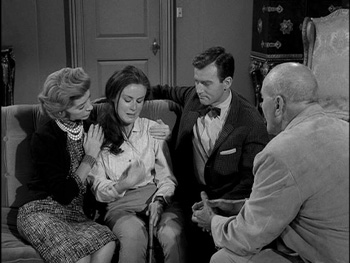
ORIGINALLY BROADCAST AS EPISODE 141
STARRING CAST: Diana Hyland, Marsha Hunt, Philip Ober, Roger Davis
WRITER: Richard Matheson
DIRECTOR: Elliot Silverstein
SUMMARY: Anne Marie Henderson goes out horseback riding and sees a woman who resembles her, on a stallion and dressed in a cape, who rides down from a cliff and chases after her. David, who loves her and wants to marry her, but whom her father can't stand, comes to her home begs for her to run away with him. Then twenty-five years elapse and the man that Anne married drove her into alcoholism and spent all her wealthy family's money. But the man she married was David, who is also a broken-down alcoholic.
REVIEW: V
"When I first asked Diana Hyland if she could ride a horse, she gave the stock answer that an actor would give: 'of course', and then when it came time to shoot it, she didn't even know what side of the animal to get up on!", remarked Eliott Silverstein many years later.
"Spur of the Moment" was "Twilight Zone" at its weirdest, with an unusual cast of gifted actors - Diana Hyland (a remarkably gifted actress who won an Emmy for "The Boy In the Plastic Bubble" shortly before her untimely death in 1977), Marsha Hunt (who made her first film in 1935 and was the star of numerous films including the 1947 oddity called "Carnegie Hall", sharing scenes with the likes of Jascha Heifetz) and Philip Ober (a familiar face on numerous sitcoms), coupled with Richard Matheson's quirky script, make for a gruesome half-hour. Anne Marie's future self tries to warn her not to marry David, but she doesn't heed the warning. But what kind of warning is it, really? What if *Robert* was the wrong man for her, as well? The woman chasing her is clearly an older lookalike who does little more than traumatize. Would she have married someone else as a result of the experience? Perhaps, but perhaps not. Marsha Hunt says of the episode, "It really wasn't one of the better ones. But Diana Hyland was an exceptional talent; like Rod Serling, who was also a good friend, she left us way too soon."
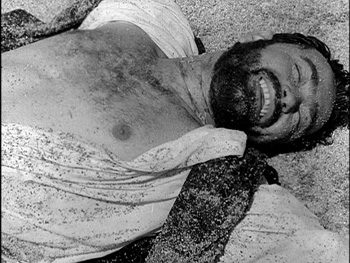
ORIGINALLY BROADCAST AS EPISODE 142
STARRING CAST: Roger Jacquet, Anne Cornaly
WRITER: Robert Enrico, based on the short story by Ambrose Bierce
DIRECTOR: Robert Enrico
SUMMARY: Peyton Farquhar gets hanged, but before he expires, he momentarily gets a chance to go home to his wife.
REVIEW: I
This classic short film was the only episode not produced by Cayuga Productions. Serling's narrations were tacked onto both ends of the classic adaptation of Ambrose Bierce's short story, filmed in France. Starring Roger Jacquet, it is a thought-provoking fantasy, often shown in high school and college English courses. Peyton Farquhar manufactures for himself one last taste of love before he goes to the great gates of Hell after being hung at Owl Creek Bridge. The nearly silent film is accompanied by music of Henri LaNoe, a song called "The Living Man" plus snare drum rhythms as Farqhuar makes his way through a never-ending woods, there is a visceral earthiness to it, all the while propelled by an immense urgency of Farquhar to return home to his devoted wife. He almost arrives in time.
"Occurrence at Owl Creek Bridge" is not currently in syndication. The reasons for this are not clear, forty-odd years after the fact. It could be that because the film was purchased as a solution to a budgetary problem - Cayuga Productions had reportedly gone far overbudget by the time they closed up shop after five years. Therefore, because it was not a direct product of the company, it may have later been sold back to its original copyright owners. At any rate, the film, in episodic form, remains on the currently-issued DVD sets produced by Image Entertainment, Inc.
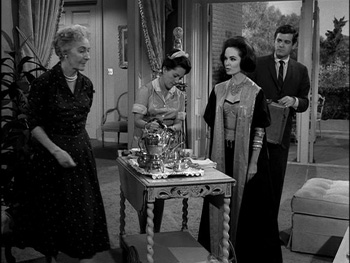
ORIGINALLY BROADCAST AS EPISODE 143
STARRING CAST: Ann Blyth, Lee Philips, Celia Lovsky, Frank Ferguson
WRITER: Jerry Sohl
DIRECTOR: John Brahm
SUMMARY: Sultry movie star Pamela Morris uses a scarab to suck the life out of younger people who come into contact with her, then uses it to transfer the life to herself and make her immortal!
REVIEW: IV
A late follow-up episode to Beaumont's "Long Live Walter Jameson" was Jerry Sohl's mini-thriller "Queen of the Nile", credited to Beaumont. Movie queen Pamela Morris has the ability to usurp years from unsuspecting reporters who come to her home; Ann Blyth does quite nicely in the part, juxtaposing the charming and the wicked with flair. Like Barbara Jean Trenton in "The Sixteen Millimeter Shrine", the character is total-Hollywood. But while Barbara Jean ages, Pamela Morris has the power to escape aging and ageism. Perhaps the most impressive aspect of the show is the Egyptian decor used in the sets for the actress' home, which includes a scarab beetle kept in a glass box and a 1940 portrait of Ann Blyth (although it is not clear if the painting was done for the show or whether it was Blyth's own property). Lee Philips - a fine actor who also worked as director on many shows of the day - is in top form as the reporter who catches on to the actress' sultry tricks, nearly falling in love with her in the process. Although the photography of Jordan Herrick's death sequence is a far cry from Walter Jameson's of four years earlier, Philips plays it very convincingly. Who knows how many lives Miss Morris has taken, or will take...or just exactly how long she has lived...in "The Twilight Zone".
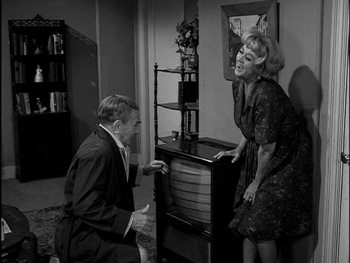
ORIGINALLY BROADCAST AS EPISODE 144
STARRING CAST: William Demarest, Joan Blondell, Sterling Holloway, Herbert Lytton
WRITER: Martin M. Goldsmith
DIRECTOR: Richard L. Bare
SUMMARY: Joe Britt falls victim to something he sees on the boob-tube...himself with another woman!
REVIEW: IV
"What's In the Box" featured veteran actors Joan Blondell and William Demarest (who replaced the deceased William Frawley as Uncle Charley on "My Three Sons" a year later) as Joe and Phyllis Britt, an older New York blue-collar couple who are bored with life and sick to death of each other. Written by Martin M. Goldsmith, it uses a number of plot elements from "A Most Unusual Camera", "A Thing About Machines", and other episodes, and in so doing results in little more than a mish-mash of odd ideas that "Twilight Zone" had done before and better. However, there are two positive elements - the characters played by Blondell and Demarest are very easy to identify with and Sterling Holloway submits a memorable performance.
Joe Britt may be a philanderer, but it's obvious that he has far more substance than Phyllis. He admits his faults and wants resolve. She wants to hear none of his remorse, instead determined to hold him to his unsightly ways. Hearing his fate on the TV after collapsing in shock, Joe rushes to the set, while disbelieving Phyllis torments him further. A pathetic fight scene ensues, Joe throws a punch and she goes out the window. No sooner than Phyllis hits the sidewalk, police and neighbors are at the door holding Joe at gunpoint, in a matter of seconds, along with the TV repairman. What perfect timing; he just happened to be in the building?!
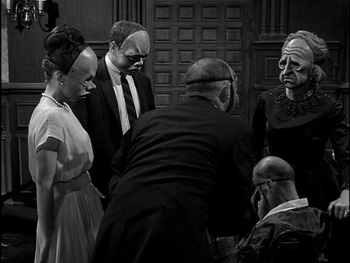
ORIGINALLY BROADCAST AS EPISODE 145
STARRING CAST: Robert Keith, Milton Selzer, Virginia Gregg, Alan Sues, Brooke Hayward, Bill Walker, Willis Bouchey
WRITER: Rod Serling
DIRECTOR: Ida Lupino
SUMMARY: Jason Foster, wealthy man on the brink of death, is paid a visit by his greedy relatives who are only there to cry 'bon voyage' and collect their share of his life's worth. They get what they came for, but it is Foster who has the last laugh.
RATING: I
Directed stylishly by Ida Lupino, "The Masks" was undoubtedly the finest of the last group of shows originally aired. Starring Robert Keith as a dying man named Jason Foster and co-starring Virginia Gregg and Milton Selzer as his unscrupulous daughter and son in law, this is a marvelously sophisticated tale about comeuppance and retribution.
Mardi Gras happens outside, while Foster forbids them to attend it and instead hosts his own party indoors. But it's a party that only he enjoys; the rest of them are just waiting for the old bastard to croak. The fateful post-supper surprise: Foster demands that they all wear masks that evidently have "certain properties", and (falsely) "reflect all the characteristics that they DON'T have." Of course, this was just a ploy to get them to comply. Foster himself opts to wear a mask, the face of death, the very thing that stalks him. Several minutes before midnight, Foster lets them all know that the end is only moments away. He dies quietly as the clock strikes midnight. Finding no pulse, they remove the masks, horrified to find their faces amended to reflect all that was inside them.
The exchanges between Foster and the relatives are usually long-winded insults that at times get to be over-talky. They have a characteristic candor and are not without comedic flavor. His daughter, Emily, enters the room and immediately starts whining about her own ailments. "You've been at death's doorstep so many times in the last twenty five years, it's a wonder you haven't worn a hole in the mat," he sputters. He lays into his son-in-law Wilfred that, "If someone were to cut you open, all they'd find is a cash register." To his grandson Wilfred Junior, "The same pleasure that most people get from a kiss or an embrace, you get by torturing small animals." To his granddaughter Paula: "The world to you is no more than a reflection of yourself," as she looks at herself in the mirror constantly. Clearly they aren't there to say goodbye, only to clean him out after he croaks. If only real life, where this happens every day with greedy family members, could bring such retribution, eh?!
Generated by William Tuttle and staff, The Masks were superlative. In "Eye of the Beholder", Tuttle and his crew had maufactured latex, pig-like face masks that went over each actor's face. Each was very much similar, reflecting their presence in a totalitarian society. In "The Masks", dense make-up layers were applied to Selzer, Gregg, Alan Sues and Brooke Hayward. Individual features of each person's face remain, but prominent features were "destroyed" just enough to give the quartet a truly horrific disfigurement. "You're characatures!", Foster says to them. "All of you! Without your masks, you are characatures!"
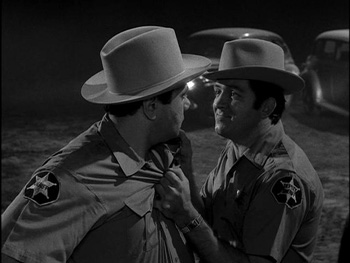
ORIGINALLY BROADCAST AS EPISODE 146
STARRING CAST: Michael Constantine, Terry Becker, Paul Fix, Ivan Dixon, George Lindsey
WRITER: Rod Serling
DIRECTOR: Abner Biberman
SUMMARY: Hatred plagues a small midwestern town and causes the surrounding area to go dark.
REVIEW: IV
"I Am the Night - Color Me Black was a third-rate script with first-rate acting by Paul Fix, Ivan Dixon, Terry Becker (best remembered for "Voyage to the Bottom of the Sea"), and veteran character actor Michael Constantine. Most of the accolades go to Dixon, playing the respectable 'wise owl' of a reverend, the only really decent figure amongst a midst of small-town folkies. Lindsey (perenially known as the equally-annoying character Goober Pyle of "The Andy Griffith Show" and later "Mayberry RFD", which he was playing at the time) is hilarious as the lispy, backmouthing town deputy. The rather muddy idea of Serling's was executed well, and the remote town mentality emerges quite vividly. The conclusion, though weak (hatred can kill the street lamps, too?!) does make its point nicely, in the same vein as many of the more notable Serling pieces on prejudice.
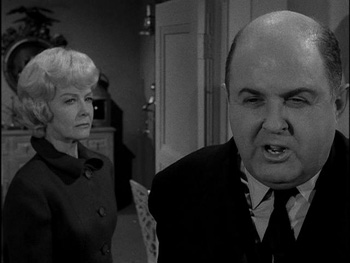
ORIGINALLY BROADCAST AS EPISODE 147
STARRING CAST: John McGiver, Penny Singleton, Michael Fox, Francis Desales, Bill Benedict, Renee Aubry
WRITER: Rod Serling
DIRECTOR: Richard Donner
SUMMARY: Roswell G. Flemington, owner of a model ship building company, enjoys noise and eventually goes deaf as a result.
REVIEW: VI
School-teacher-turned-character actor John McGiver was cast for the lead in "Sounds and Silences", the complementary episode to "A Kind of Stopwatch". This is essentially the same story, the only difference being the main character, a model ship building company whose owner insists on listening to sea chanties such as "Anchors Aweigh," and sounds of ships being torpedoed in WWII, who has a fed-up wife (played by Penny Singleton, star of the 1934 film "Blondie" and the voice of Jane Jetson on "The Jetsons"). In the end, Flemington gets his just rewards and goes insane, and nobody is the wiser for it. Owing to some dispute with a writer who wrote a story with a similar idea, this episode was out of syndication for twenty years after its initial airing.
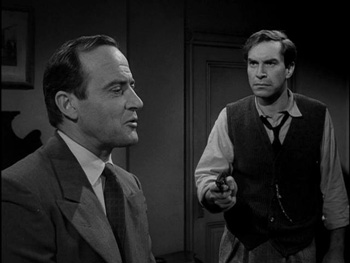
ORIGINALLY BROADCAST AS EPISODE 148
STARRING CAST: Martin Landau, John Van Dreelen, Robert Kelljan
WRITER: Rod Serling
DIRECTOR: Richard Donner
SUMMARY: Major Ivan Kuchenko is attempting to go west, but has been marked and assigned to be killed by Vasiloff. Through a most ingenious plan of action, he manages to escape.
REVIEW: IV
In "Mr. Denton on Doomsday", Martin Landau used his piercing eyes and violent expression to good effect, and here he got the chance again. While there is no fantasy element to "The Jeopardy Room", the appeal comes from the most ingenious plans of the assassinators. Both Kuchenko and Kommisar Vasiloff get their chance at trickery and while it seems inevitable that Kuchenko will be the one who dies, the turnout is surprisingly fitting, if not a bit tidy. After all, what are the chances that Vasiloff and his assistant were to be in the room where the bomb is planted, an hour or so later after Kuchenko escapes? Poetic justice in "The Twilight Zone".
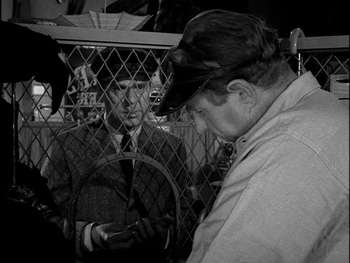
ORIGINALLY BROADCAST AS EPISODE 149
STARRING CAST: Jackie Cooper, Suzanne Cupito, Sarah Selby, Olan Soule
WRITER: Adele T. Strassfield
DIRECTOR: Robert Butler
SUMMARY: Irishman Jonathan West, ventriloquist, and his dummy named Caesar come to America, penniless, in search of work. They don't find any work in time, and while the bills start to pile up, Caesar suggests that West rob the local delicatessen and karaoke club.
REVIEW: VI
Several scripts in the fifth season were written by outside writers who had little comprehension of what they were doing. As a result, the stories are not so much in the traditional "Twilight Zone" story format as much as stories that recycled ideas done in previous episodes. "Caesar and Me" was really no more than a poor re-vamp of Serling's "The Dummy" written by Adele T. Strassfield, one-time secretary of producer William Froug. Supposedly there were no other suitable stories in the production lineup at the time; a story was needed, and reportedly Strassfield wrote it, the only one she has to her credit. The lead was given over to Jackie Cooper, a fine actor, director, and producer whose career in film and television spanned over sixty years. However, the character Jonathan West is so weak that it's hard to feel much sympathy for him. He's no more than a poor immigrant who would probably do well to just go back to his homeland. To see the middle-aged West being verbally beaten up by an atrocious youngster, then dim-wittingly taking Caesar's advice and robbing a karaoke club is not enough to generate any sparks and sets a bad example for the kiddies. Morgan Brittany (formerly Suzanne Cupito) relates, "I've always had long hair but they had me cut it for that episode because they wanted me to be a tomboy, similar to what Mary Badham's Scout in "To Kill a Mockingbird." That script, and also "Valley of the Shadow" marked the beginning of my days as a TV villainess, that's for sure."
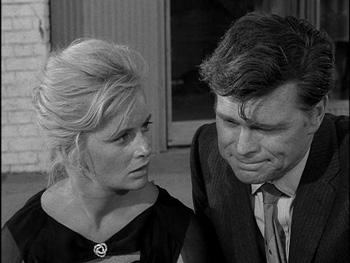
ORIGINALLY BROADCAST AS EPISODE 150
STARRING CAST: Barry Nelson, Nancy Malone
WRITER: Earl Hamner, Jr.
DIRECTOR: Ron Winston
SUMMARY: Bob and Millie Frazier wake up one Sunday morning in an unfamiliar bedroom...in an unfamiliar town. They scout around the town, but the only form of life seems to be the voice of a little girl laughing at them from a distance.
REVIEW: II
"Stopover in a Quiet Town" made an impact, and even this many years later remains somewhat identifiable. It benefits greatly from superior production and dead-on portrayals by Barry Nelson and Nancy Malone, but the kind of people they are is a bit less than hoped for - New York dinks who trash themselves on Sunday nights and can't make it home in time to get up for work the next morning. Nonetheless, Earl Hamner's story is one of "Twilight Zone"'s spookiest.
One superb moment comes when The Fraziers find what looks like a real squirrel. Thinking it is tame, Millie touches it gently and it falls over, dead...it's stuffed. Also nice is the inclusion of a train, which would likely have been their ticket out of the place, but it only goes in a circle.
Bob Frazier is the more frustrated of the duo, calling out to no one in particular, "Give me the big city any day! At least then you know you're being stared at!" Like any of the best, it sets up a burning question that awaits a good answer. The payoff is a nice shocker - it turns out that they were captured by a huge giant from another planet, who brought them back as pets for his daughter. The girl has all the traits of an Earthling and given the human size of the Fraziers and the giant size of the people on this other planet; the physics don't quite add up. But wouldn't we all like to escape from the real world and become residents of a papier mache village with electric trains?! Whatever the case, Bob and Millie Frazier won't ever be going home from the Twilight Zone they stepped into, no matter how fast or how far they run!
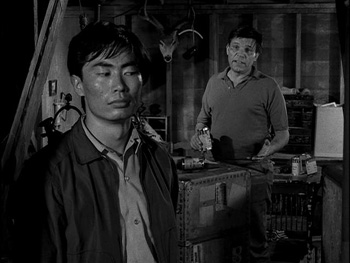
ORIGINALLY BROADCAST AS EPISODE 151
STARRING CAST: Neville Brand, George Takei
WRITER: Martin M. Goldsmith
DIRECTOR: Robert Butler
SUMMARY: An ex-marine who had trouble going back to civilian life meets a Japanese gardener whose father was responsible for bombing Pearl Harbor.
REVIEW: IV
"The Encounter" is the only episode produced by Cayuga Productions that remains out of syndication. Although it featured two fine talents - George Takei (Captain Sulu of "Star Trek") and Neville Brand (one of the great Western roughneck actors of the yesteryear and a war vet himself), the material is so harsh and out of character for "Twilight Zone", it is probably just as well that it remains on the back burner.
Writer Martin M. Goldsmith tackled an oddity with "What's In the Box". The theme was a blue-collar household that succumbs to the boob-tube. Here, he tackled another blue-collar fantasy but this time with racial overtones. But it is all completely pointless and includes one violent death and and an unnecessary death of a decent man. Sure, there were many redneck war vets like this Fenton around in the day, and there still are. Most have a wealth of good stories on hand, in addition to the bloody ones, and most are at least somewhat likeable. Fenton is merely a repulsive, "Chinkie"-barbing drunk who recently lost both his job and wife within a week. The somber-faced Taro, naturally, is relegated to tending gardens for a living, still hanging onto the anguish of his own father being a traitor to the Japanese race by instructing the enemy to bomb Pearl Harbor. Both beaten up by their own guilt, Fenton falls on his sword and Taro jumps out the window, and no one is the wiser for it. After both men die, the door to the attic (which had become inexplicably stuck when Taro came in) swings open, perhaps to symbolize the equality of the two men and a momentary end to racial indifference?
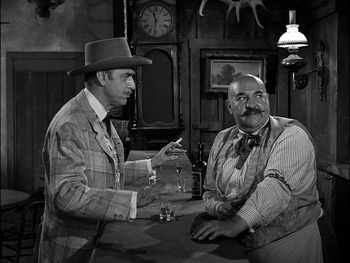
ORIGINALLY BROADCAST AS EPISODE 152
STARRING CAST: John Dehner, Stanley Adams, Percy Helton, Norman Leavitt, John Mitchum
WRITER: Rod Serling, based on a story by Mike Korologos
DIRECTOR: Ted Post
SUMMARY: Mr. Jared Garrity pulls into town in a covered wagon, intent on selling some of his services to the town...he can bring back the dead, or he'll take payments from their heirs who don't want them back alive!
REVIEW: III
This tale of the old west starring the marvelous Stanley Adams and "Twilight Zone" veteran John Dehner was amusing. Although it is a little unlikely that each of the townspeople in Happiness, Arizona would be rich enough to afford $500 to keep their dead relatives dead, the fantasy is in Garrity's gross underestimation of his own talents. But the scandal remains - he does raise the dead after collecting the payments, and the whole town is surely in for a wicked surprise!
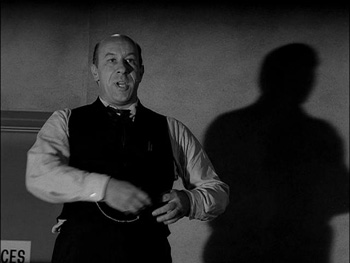
ORIGINALLY AIRED AS EPISODE 153
STARRING CAST: Richard Deacon, Paul Newlan, Ted DeCorsia, Jack Crowder
WRITER: Rod Serling
DIRECTOR: Richard Donner
SUMMARY: Wallace V. Whipple, factory owner, lays off the entire plant and replaces the employees with computers as a way to beat budgetary problems.
REVIEW: V
Like he'd done with "Uncle Simon", Serling wrote a story that incorporated Robby the Robot, this time about job security and technology at the expense of human welfare. Legendary baritone-voiced character actor Richard Deacon took a week off his chores on "The Dick Van Dyke Show" to play Wallace V. Whipple. He does quite well in the part, although the dialogue he was given is hilariously run-on. A good addition to the cast - with an 'ultra' baritone voice was Ted de Corsia as the foreman Dickerson, well-known for his ability to play heavies and rather rotten characters (he earlier played the movie studio executive in Serling's "The Sixteen Millimeter Shrine"). Despite Serling's overly talky script, the scene where he drunkenly attacks one of Whipple's new computers makes its point well. [Interesting side note, the same scene for many years played on a monitor in the Smithsonian, as a display of Serling's foresight into our soon-to-be overmechanized culture which, once started, would never subside]
DICKERSON: I've worked at this plant for THIRTY YEARS! And I've been a foreman for SEVENTEEN of 'em! In my book, that gives me some rights, Mr. Whipple!
WHIPPLE: Well, you've got the wrong book, Dickerson! My book reads as follows: You're drunk and disorderly and trespassing on private property and therefore subject to arrest!
DICKERSON: Tell me somethin', Mr. Whipple! When you're DEAD AND BURIED, who'dya get to MOURN for ya?!
WHIPPLE: Shall I tell you the difference between YOU and IT? That machine costs two cents an hour for current. It gets no wrinkles, no arthritis, no hardening of the arteries! That one machine is a lathe operator, a press operator. Two of those machines replace a hundred and fourteen men who take no coffee breaks, no maternity leaves, no vacations with pay! And THAT, in my book Mr. Dickerson, is worth considerably more than you are.
DICKERSON: They shoulda stopped you a year ago!! Somebody shoulda held you down and put a bit in your head and poured in some reminders that men have to eat and work!! And you can't pack 'em in cosmoline like surplus tanks or put 'em out to pasture like old bulls! I'm a MAN, Mr. WHIPPLE, ya HEAR ME?! I'm a MAN!! And that makes me better than this hunk of metal! Better! BETT-E-RRRRR! Betterrrr.... (Dickerson takes a crow bar to the computer and it bursts into flames. Dickerson falls over, seemingly dead, as Whipple grabs gun from security guard and shoots him.)
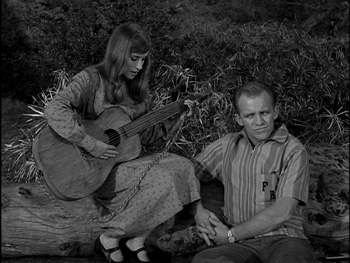
ORIGINALLY BROADCAST AS EPISODE 154
STARRING CAST: Gary Crosby, Bonnie Beecher
WRITER: Anthony Wilson
DIRECTOR: Richard Donner
SUMMARY: Rock singer Floyd Burney heads for the backwoods in search of new songs to sing, and meets much more than he expects to find.
REVIEW: V
One of the weakest - although unintentionally - of all 156 "Twilight Zone" episodes was this number by Anthony Wilson (who later was a story editor on "Lost in Space") that featured Bing Crosby's son, the late Gary Crosby. The younger Crosby had none of his elder's talent and one suspects that his agents were looking hard for something for him to do. And luckily, he got a part on "Twilight Zone". A few different sources have stated that he wasn't the first choice for the role, but he impressed the higher-ups and apparently got the part. But the Floyd Burney character was not written well and it makes the episode that much more difficult to watch. "Gary Crosby was a nice guy," said his friend Gloria Pall. "I knew him for years; unfortunately, he died long before he should have." The TZ episode marked Bonnie Beecher's TV debut. Her career ultimately never left the ground, although her later performances on "Gunsmoke" and other shows of the day display her competence as an actress.
The story is supposed to be a cycle (as evidenced by Burney's headstone being shown at the beginning and end), but the cycle itself has no rhyme or reason. Most of the great "Twilight Zone" episodes set up questions that are eventually answered, and if they're not, it is because they don't demand a definite answer. "Come Wander With Me" poses many different queries that lead nowhere; the viewer can't help but be utterly confused as things spin out of control. One moment Mary Rachel is dressed in hippie attire, and the next she's dressed in something that resembles a nun's habit. Sadly, it comes off as a collection of workable plot elements that, together, simply don't work. William Froug: "It read well on paper but it was one of a few shows I did that just didn't work for whatever reason. I had another script that was in the pipeline that year called "Many Many Monkeys" that was one of my worst...I'm glad we didn't do it." But somehow, the episode remains at least somewhat popular for its "so bad, it's good" status! Gary Crosby reportedly said at the time that he was very confident about the outcome of the episode. It's unknown if he ever saw it or not; judging from what was ultimately released, it may have been better if he hadn't seen the finished product. "I knew Gary Crosby quite well," remembers Gloria Pall. "He was a very nice guy. He wasn't that old when he died unexpectedly. He had a strange life but look at the family he came from...."
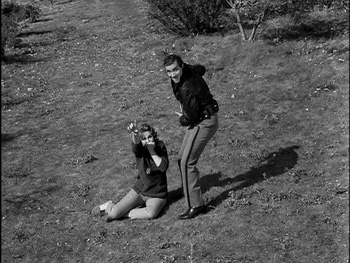
ORIGINALLY BROADCAST AS EPISODE 155
STARRING CAST: Hazel Court, Peter Mark Richman
WRITER: Rod Serling
DIRECTOR: Ted Post
SUMMARY: Charlotte Scott sees some strange-looking lights in the sky and calls the police. Trooper Franklin comes out to her cabin to investigate, and concludes that the invader must be the biggest beast walking planet Earth.
REVIEW: VI
"The Fear" offers two interesting performances by two dramatic actors with long and varied careers - Peter Mark Richman and Hazel Court. Richman, a multi-talented dramatic actor, artist, and screenwriter best known for his regular role as lawyer Andrew Laird on "Dynasty" and Court for her parts in many horror films (several with Vincent Price), they do adequately with Serling's slipshod counterpart to Matheson's "The Invaders". A giant which Trooper Franklin claims to be five-hundred feet tall overturns his patrol car and leaves gigantic fingerprints on the door. Later, they find a giant inflated one-eyed doll, clad in hip boots, placed there by mouse-sized martians who came to Earth only for the purpose of terrorizing some humans. Naturally, this is a physically impossible set of circumstances. Had the setting been conceived more like "The Little People", as a true fantasy, it would have been plausible. But given the Earthbound setting, it isn't plausible. SERLING: "Fear, of course, is extremely relative. It depends on who can look down and who must look up. It depends on other vagaries, like the time, the mood, the darkness. But it's been said before, with great validity, that the worst thing to fear is fear itself."
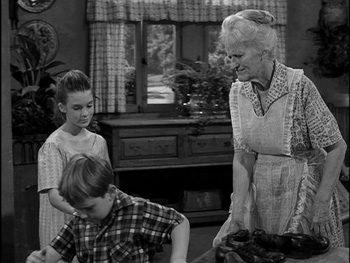
ORIGINALLY BROADCAST AS EPISODE 156
STARRING CAST: Mary Badham, Tim Stafford, Georgia Simmons, Kim Hector, Tod Andrews, Dee Hartford
WRITER: Earl Hamner, Jr.
DIRECTOR: Joseph M. Newman
SUMMARY: Jeb and Sport Sharewood leave their despicable parents via their swimming pool and take up new residence in a magical kingdom with other kids in another world.
REVIEW: V
Earl Hamner once again hybridized backwoods life with city life in the tale "The Bewitchin' Pool", the last episode originally broadcast. A pleasant children's story (one of only a few seen on "Twilight Zone" in five years) , the television episode fell victim to slapdash production and miscasting. Mary Badham was definitely a good choice for the lead, having played a similar character in "To Kill a Mockingbird" two years earlier. But her real voice was not used for all except a few short sequences in Aunt T's hut. June Foray was called in to do the voiceovers after the original soundtrack was deemed unusable. Although it hasn't been confirmed, the lines of Jeb Sharewood (played by Tim Stafford) also sound like they were partially dubbed.
Numerous elements go by unexplained, the most curious of which is the choice of names for the children, Jeb and Sport (certainly a take-off on Jem and Scout Finch of "To Kill a Mockingbird"). The children are from a wealthy, suburban west coast family, yet they speak with thick Southern accents while their parents do not. Worst of all are the parents, who constantly say, "darned you loudmouthed kids!" (I don't think they know the meaning of the term 'loudmouth') and say the very thing that should never be said, "it's because of you two that we've stayed together as long as we have!" Two opening narrations by Serling (the usual one in the teaser plus another that opens the first act), as well as the exact same footage for the beginning and ending of the episode were used due to lack of enough filmed material to fill the entire 22 minutes.
The sequences in the ersatz Never-Never Land would have succeeded had a different actress been cast as Aunt T. Jeanette Nolan had done splendidly as Rachel Simpson and Granny Hart; Georgia Simmons, in good costume but bordering on urbane in her delivery, does the part little justice. Consequently, Granny comes off as more like a grandmother from the south than a magical mother figure in a magical kingdom.
Ultimately, the kids get to stay in Aunt T's kingdom, away from their rotten maternal parents, thus ending the original run of "The Twilight Zone" on a happy note.
And so, "The Twilight Zone" concluded, unceremoniously and with not a lot of fanfare. It had attracted an audience of some eighteen-million viewers per episode in its prime, and most of those eighteen-million would go on to become loyal watchers of the show in reruns. The reruns, of course, were usually chopped up and had multiple scenes deleted, but thankfully in the 1980s the show was released by CBS Video Library so viewers could once again view the episodes in original, uncut form. The 1980's also saw a few attempts at reviving the series - the debut of "The Twilight Zone Magazine" in 1981, the movie version in 1983 and another series bearing the name "The New Twilight Zone" in 1985. Needless to say, neither of the screen revivals bore much relation to their 1960s predecessor and the magazine lasted until 1989.
In 1995, the show was picked up by The Sci-fi Channel and thus began a tidal wave of "Twilight Zone" resurgence that has not quite ended as of this writing. At the same time, the internet was slowly beginning its big boom and fine websites on the show were developed over the next several years. Now viewers could download visual stills and audio files of Serling talking, as well as computer desktop themes featuring elements from the show's episodes. In 1999, the first of a four-part trading card series was released, featuring trading cards and individual autographed cards signed by such luminaries from the show as Anne Francis, Rod Taylor, and William Shatner. In 2002, the first-ever Twilight Zone event was held in Hollywood, a two-day convention featuring 57 actors from the original series, plus panel discussions with ten actors including Cliff Robertson and Anne Francis, directors James Sheldon and Elliot Silverstein, and writers Earl Hamner, George Clayton Johnson, and John Tomerlin. The 2002-2003 lineup on UPN included yet another reincarnation of the series, along with the debut of the original scripts converted into radio dramas. Needless to say, neither project ever got off the ground. A second convention was done in 2004, this time featuring sixty-five celebrities. 2005 saw the fourth series of tribute Zone trading cards and re-releases of the show on DVD and in 2006, a phenomenal third "Twilight Zone" Convention in New Jersey. Two more conventions followed in 2007 and 2009. It seems that "The Twilight Zone" will never die.
© 2002-2015 The Twilight Zone Museum. All Rights Reserved. Use of the material herein without written permission from the author is strictly prohibited. See website disclaimer for details.
